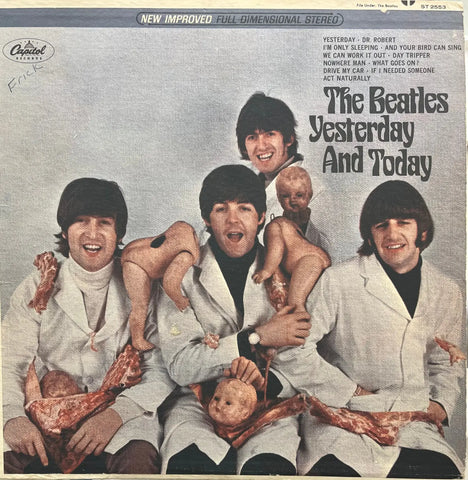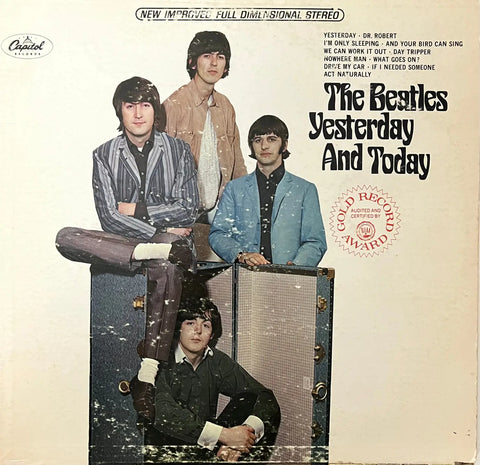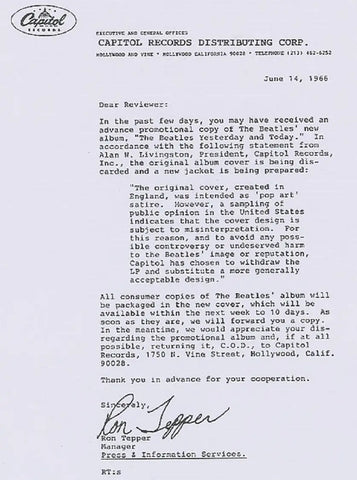The Beatles Yesterday and Today album's original Butcher cover is one of the most infamous album covers in the history of rock music. Released in 1966, the album initially featured a cover photograph that depicted the Fab Four dressed in butcher smocks, covered in pieces of raw meat and dismembered baby dolls. This shocking and controversial cover art was quickly withdrawn by the record label, Capitol Records, and replaced with a more conventional cover, making the original "Butcher cover" a rare and highly sought-after collector's item.

The story of the Butcher cover begins with The Beatles' rapid rise to fame and success. By 1966, the band was already an international sensation, with hit songs, critically acclaimed albums, and a massive fan following. They were also experimenting with their music and image, pushing the boundaries of what was expected from a popular music act. The Yesterday and Today album was intended to be a compilation of previously released tracks for the North American market. However, the Beatles decided to use this opportunity to make a statement.
The album's original cover was designed by the famed photographer Robert Whitaker. Whitaker was known for his avant-garde and controversial photography, and the Butcher cover was no exception. The cover art concept was the brainchild of John Lennon, and it was intended as a protest against the way Capitol Records had "butchered" their albums for the American market. The Beatles were unhappy with the way their albums were altered in the United States, with tracks rearranged and sometimes omitted to create a different product from the original UK releases.
The Butcher cover was meant to be a subversive and satirical commentary on the music industry. The Beatles donned white butcher smocks and posed with pieces of raw meat and dismembered baby dolls, creating a surreal and unsettling image. The dolls were meant to symbolize how they felt like puppets being controlled by the industry. It was a bold and provocative statement, especially for a band as beloved and influential as The Beatles.
When the album was initially released with the Butcher cover in June 1966, it created an immediate uproar. Many fans and music retailers were shocked and appalled by the cover, finding it tasteless and disturbing. There were also concerns that it would be seen as disrespectful to the memory of John F. Kennedy, whose assassination had occurred less than three years earlier.

The replacement design, dubbed the "Trunk cover"
Amid the controversy, Capitol Records decided to recall and replace the Butcher cover with a more conventional cover featuring the Beatles gathered around a steamer trunk. This new cover, known as the "Trunk cover," was used for subsequent pressings of the album. The Butcher cover was pasted over with the new cover image, and many copies of the original cover were destroyed or returned.

The Capitol recall letter was rushed out
Today, the original Butcher cover is a highly sought-after collector's item and one of the most valuable Beatles collectibles. It's estimated that only a few thousand copies of the Butcher cover survived the recall, making it a rare find. The cover's value has increased significantly over the years, with pristine, unpeeled Butcher covers fetching astronomical prices at auctions. These are known as "first state" Butcher covers.
The "second state" variety is an unpeeled cover that has the Butcher artwork underneath. These can be detected by a keen eye spotting the v-neck of Ringo's black shirt on the right side, showing through the white area on the Trunk cover.
As to the pasted-over copies of the album, crafty fans and collectors have carefully steamed off the Trunk cover to reveal the original cover underneath. While this process often ended with a very poor result, i.e. a torn up cover with little value, since it is very, very difficult to do, some very skilled "peelers" created some very good collectibles, known as "third state" Butcher covers. Most experts trust only a tiny handful of "peeler pros" worldwide to perform the tricky procedure.
The Butcher cover incident had a lasting impact on The Beatles and their relationship with Capitol Records. It marked a turning point in the band's career, as they gained more control over their music and releases, leading to the creation of albums like Sgt. Pepper's Lonely Hearts Club Band that challenged the conventions of the music industry.
In retrospect, the Butcher cover stands as a symbol of The Beatles' artistic and cultural influence during the 1960s. It was a statement of rebellion and a challenge to the status quo, reflecting the band's desire to be more than just pop stars. It remains a fascinating and controversial chapter in the history of popular music and an enduring symbol of The Beatles' enduring impact on the world of music and art.
Check out our selection of Beatles memorabilia including, at time of article writing, a rare Butcher cover here.
Interested in genuine, properly authenticated signed music memorabilia? Check out our selection here. How about genuine RIAA Gold and Platinum and other record awards? Check out our selection here. We typically have hundreds in stock.
Want more content like this? If you're not a subscriber already, sign up for our free MusicGoldmine newsletter which comes out every two weeks. Go here to sign up plus get a code for 15% off your first purchase.
Be the envy of all your friends! Get MusicGoldmine.com Music History in your Facebook feed each day. Just follow us on Facebook here.



